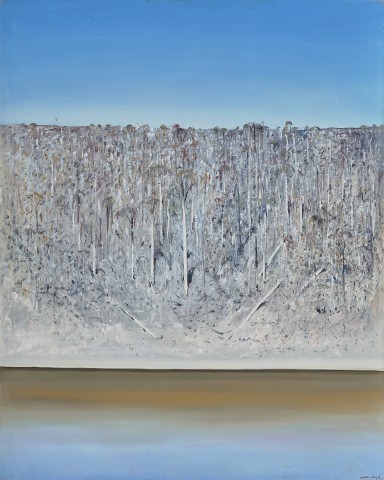RIVER-BUSH HOMAGE TO POLLOCK, 1976
ARTHUR BOYD
oil on canvas
152.5 x 122.0 cm
signed lower right: Arthur Boyd
Bonython–Meadmore Gallery, Adelaide
Leasefin Corporation Limited, Melbourne
The Leasefin Sale of Australian Pictures, Christie's, Melbourne, 28 July 1991, lot 1
John Barnes, Melbourne, acquired from the above
The Estate of John Barnes, Melbourne
McGrath, S., The Artist and the River, Bay Books, Sydney, 1982, pl. 179, pp. 178, 179 (illus.)
‘The natural beauty of the Shoalhaven area caused Boyd to marvel constantly. His paintings are a celebration of grandeur and wonder of Nature. It is to Boyd’s credit that a single landscape can inspire such diversity of work. He gives us the impression that there are infinite possibilities, as long as we train ourselves to see.’1
Eager to rediscover his roots, his ‘Australianism’, after more than a decade abroad, in 1971 Arthur Boyd returned to the country of his birth to take up a Creative Arts Fellowship at the Australian National University in Canberra. Over the blazing summer of 1971 – 72, Boyd and his wife Yvonne were invited by the Sydney art dealer Frank McDonald to visit Bundanon for the weekend, staying at a home he shared on the south coast of New South Wales with art historian Sandra McGrath and her husband Tony. Here the artist’s joyful rediscovery of the Australian bush with its stark contrasts and clarity of light was nothing short of an epiphany, and thus in 1974, Boyd purchased the nearby property Riversdale on the banks of the Shoalhaven River. Once again the magic of the dour, untamed Australian landscape became the impetus for his art, and over the subsequent twenty-five years until his death in 1999, Boyd would dedicate himself almost exclusively to capturing the myriad moods of the Shoalhaven in images that are today imprinted upon the national psyche as some of our most beloved and iconic.
Soul-piercing in its beauty, the Shoalhaven region offered both refreshing solace for the artist’s world-weary eyes, and endless potential as a subject – ‘the variation in the area with its great deep tones and high keys’ bearing strong affinities with music. As Boyd elaborated, ‘in the desert there is only one note, just one low singing note. In this landscape the tonal range – not tonal in the obvious sense of colour, but the actual fact of the horizon which can vary from very high to low, to infinite, depending on your line of vision – makes it a greater challenge. It has a knife-edged clarity. Impressionism could never have been born here, but Wagner could easily have composed here…In fact,’ he added with characteristic playfulness, ‘I actually think Wagner lived in the Shoalhaven.’2 Wild and primordial, the region differed completely from the ordered English countryside to which he had grown accustomed and thus, a new vision was required to unlock its tangled mysteries. If previously Breughel and Rembrandt had offered inspiration, now Von Guérard, Piguenit and Buvelot became Boyd's spiritual mentors.
Painted a world away in his studio in England, River-Bush Homage to Pollock, 1976 offers a monumental example of the ‘pure’ Shoalhaven landscapes which – devoid of the mythological creatures and symbolic narrative punctuating versions elsewhere – simply pays homage to the sheer grandeur and beauty of Nature. Perhaps owing to its execution abroad, the work arguably bears a more cerebral, abstract quality than those iterations undertaken in the Shoalhaven, while Boyd’s title alludes to his unique experimentation here with the revolutionary technique of his radical New York abstract expressionist predecessor: ‘I call it ‘Homage to Pollock’ because in the details I used the same drip pattern-making approach that Pollock used.’3 Exuding a primeval stillness notwithstanding its painterly innovation, River-Bush Homage to Pollock is a poignant reminder of how Boyd, comfortable once more with the eternal diversity of the Australian landscape, ultimately did tame his wilderness: ‘...what was unfamiliar became familiar, what was menacing became friendly, what was awesome became intimate.’4
1. McKenzie, J., Arthur Boyd at Bundanon, Academy Editions, London, 1994, p. 42
2. Boyd quoted in Pearce, B., Arthur Boyd Retrospective, exhibition catalogue, Art Gallery of New South Wales, Sydney, 1993, pp. 26 – 27
3. Boyd cited in McGrath, S., The Artist and the Shoalhaven, Bay Books, Sydney, 1982, p. 178
4. McGrath, ibid., p. 79
VERONICA ANGELATOS


